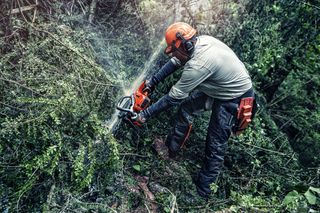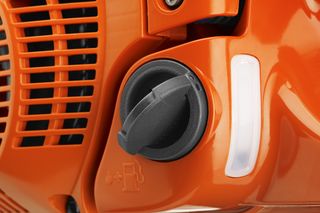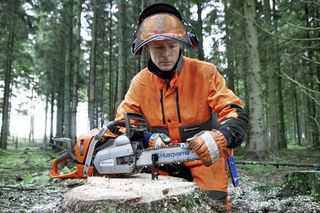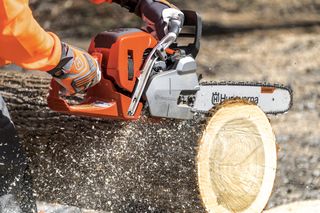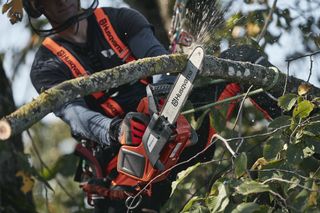
Chainsaw chain guide - measurements, sizes and types
There’s nothing worse than a dull chainsaw chain. Professionals swear by sharpening their chain regularly, often, after each use. But like any serviceable part, your chainsaw’s chain will eventually wear out and will require replacement. When it comes time to replacing your chain, it can be a little daunting knowing where to start if you haven’t done it before. Of course, a good starting point is to refer to your chainsaw’s operation manual. But what if you want a different cut? Or you want to change the bar? Once you understand the different measurements, sizes, and types available, things become much clearer. If the time has come to replace your chainsaw chain and you are not quite sure where to begin, the following information should put you on the right track. Let’s begin by first looking at the important numbers you need to know.
The three key chain measurements
These three measurements will give you all of the information you need to get the perfect chain for your chainsaw.
Pitch
To work out the pitch measurement you are going to need a tape measure. To get the correct size, simply count 3 rivets on the chain and measure the distance between them from the centre points. Now divide this by half to get your size. As an example, three rivets that measure ½ an inch across divided by two gives you a pitch of a ¼ inch. Make sure you check your chainsaw (on the guide bar) and the instruction manual for the measurements too, as these are typically located in one of these two places.
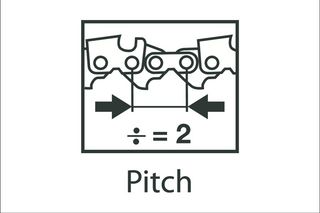
Gauge
This is the thickness of the drive links (the tooth-like underside of the chain that fits in the guide bar). The chain gauge is measured in inches and will usually be in the manual or on the chainsaw itself. As it is difficult to measure accurately with a tape measure, you may need a vernier caliper to get this measurement. There are four different gauge sizes, which are .043, 0.50, .058, .063, with the lower sizes being the most common. If you select the wrong size, it may be too thick to fit your chainsaw or too loose to gain proper traction.
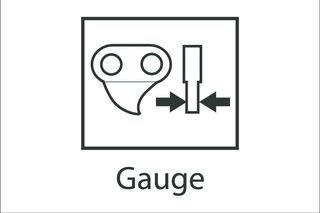
Drive Links
This is the most mundane part of the measurement process, but also one of the most important. To get a chain that is the correct size you need to count the drive links (those little teeth on the underside of the chain). One tip is to place a strip of tape on the first link and count your way around. You need to know exactly how many there are to get the correct chain size for your chainsaw. Now you have those three numbers, you can begin your search for the chain that you need. Next, we’re going to look at the chain aggressiveness.
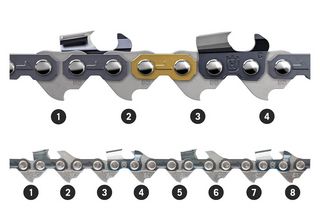
Levels of Chain Aggressiveness
This determines how smooth and fast a chain is able to cut through wood. The aggressiveness of a chain will all depend on what you intend on using it for and your level of skill.
Anti Kickback (low)
This is by far the most common chain available and has been designed to prevent kickback. Think of kickback as being a treadmill at high speed, as soon as you step on it, it throws you off. The same can happen with a chainsaw when the tip comes into contact with the piece of wood. The rotating chain effectively gets thrown back toward the user. By reducing the amount of material that can be cut at any one time, and at a slower speed, there is less chance of kickback occurring.
Skip Tooth (medium)
These chains are also commonly referred to as ‘regular’ chains. They are typically used for professional use and feature a space between each cutting link. This results in the chain having less resistance and an improved cutting rate. However, it also reduces the smooth finish that a low-kickback chain provides.
Full Skip (aggressive)
A full skip chain is at the most aggressive end of the spectrum, meaning it is able to quickly work its way through the wood it is cutting. Much like the skip-tooth, the full-skip has spaces between the cutting teeth (two links instead of one) and is intended for larger chainsaws. And while this is the fastest chain for cutting, it requires skill and experience to operate.



